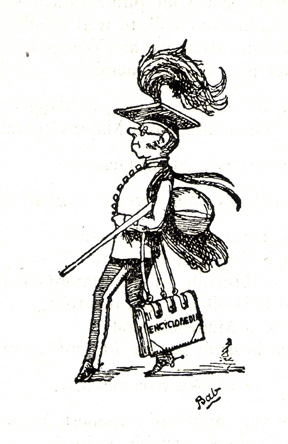
Raymond J. Steiner, Editor • Cornelia Seckel, Publisher
(845) 246-6944 ·
info@ArtTimesJournal.com
 |
When the Words Go A-Pitterpatter pt. 2
By
FRANK BEHRENS
ART TIMES November 2008
The
USE of the patter song is the next step in this examination of the genre.
Here, I think working by examples would be useful.
In
the first act of Offenbach’s “La Vie Parisienne,” a rich Brazilian shows
up at the train station and announces in a patter tempo, “Je suis
Brasilien, j’ai de l’or”(I am Brazilian, I have gold), and so on,
slowing down in the middle section by way of contrast (and to give the
singer a chance to keep from asphyxiating). Here the patter works in
two ways. It establishes his character as devil-may-care (he will spend
his gold as quickly as he sings about doing so) and also as impatient
to get on with it.
Figaro’s “Largo al factotum” early in Rossini’s “The Barber of Seville”
also establishes his character but without any hint of impatience. Any
character who can sing such patter must be a clever fellow indeed, and
Figaro is not shy about saying so. So here the patter also shows cleverness
and boastfulness. Same patter as in Offenbach, different results!
The
Figaro in Mozart’s “The Marriage of Figaro” is also given a patter section,
as stated above, but here it shows his anger at the Count’s disregard
of their past good relationship and of the marriage bond. Two numbers
later, Don Bartolo has a very similar song with a patter section designed
to show his cleverness.
On
the other hand, the Bartolo in the Rossini “Barber” has a long aria
with a patter section in which he tells Rosina that she has gone too
far and that he will keep her under lock and key until she accedes to
his wishes. Somehow—and this might be partly due to the music
and partly due to what we know about the character—the effect
on the listener is to show what a blustering fool Bartolo is.
Consider.
The same patter format in four numbers produces quite different reactions.
I wonder if a person not knowing the dramatic context of any of them
and hearing them played by orchestra alone could discern cleverness,
foolishness or any other characteristic in them. No, it is the lyrics
and characterization that complete the process
Patter
to portray a character who thinks he is smart and is really a fool is
found in Gilbert’s Major-General Song, but in the third stanza (which
should begin at a slower tempo, a point missed by too many singers)
he cheerfully admits he knows nothing as yet of anything that qualifies
him to be a Major-General. (Would that our leaders were so frank!)
There is an even better patter song in “Patience” in which the Colonel
gives “a receipt for that popular mystery known to the world as a Heavy
Dragoon.” He simply takes “all the remarkable people in history and
rattle[s] them off to a popular tune.” The flood of names, some familiar,
some meaningful only to informed people of Gilbert’s time, delivered
in patter tempo does not show character as much as it reveals yet another
use of the patter song. It creates a MONTAGE.
This
was a device used by Walt Whitman in “Leaves of Grass.” By giving a
long, long list of details, he creates an impression of our seeing them
all at the same time, very much like a montage sequence in a film. The
same effect is given in “Barnum,” in which the only true patter song
in Broadway musicals is delivered by the title character. By listing
in patter tempo all the wonders of his show (“Fleas, A tribe of Aborigines,
Two ladies joined across the knees…”), Barnum gives the effect of telling
us about them not linearly but all at once.
One
last most unusual use of the patter song is found in the “Iolanthe”
Nightmare Song. Here the effect of the rapid changes by association
that seem so natural to a dreamer (read your Freud for details) can
be conveyed by a long narrative song delivered in an unvarying patter
tempo.
Of
course, no consideration of the patter song can omit mention of the
great Patter Trio in Gilbert’s “Ruddigore,” in which the singers openly
admit that “This particularly rapid unintelligible patter isn’t generally
heard—and if it is, it doesn’t matter”!
Note:
If any of my readers can spot a true patter song in any Broadway or
London musical other than the one in “Barnum,” I would be most appreciative.
(“Mad dogs and Englishmen” does not, I think, come from a show.)